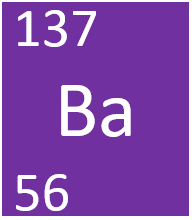Difference between revisions of "Barium"
| Line 20: | Line 20: | ||
==Key Stage 4== | ==Key Stage 4== | ||
| + | [[File:BaKS4.PNG|right|200px|thumb|The [[Chemical Symbol|chemical symbol]] for [[Barium]].]] | ||
===Meaning=== | ===Meaning=== | ||
[[Barium]] is a [[Group 2]] [[element]], on the [[Periodic Table]], with 56 [[proton]]s in the [[Atomic Nucleus|nucleus]]. | [[Barium]] is a [[Group 2]] [[element]], on the [[Periodic Table]], with 56 [[proton]]s in the [[Atomic Nucleus|nucleus]]. | ||
Latest revision as of 11:48, 5 March 2020
Contents
Key Stage 2
Meaning
Key Stage 3
Meaning
Barium is a Group 2 element, on the Periodic Table, with an atomic number of 56.
About Barium
Molecular Structure
- Barium has the chemical symbol Ba.
- Barium atoms join together in large numbers to form a giant metal molecule.
Atomic Structure
- Barium as 56 protons and 81 neutrons in its nucleus giving it an Atomic Number of 56 and an atomic mass of 137.
- An atom of Barium has only 2 electrons in its outer shell.
Properties
- Barium is a more reactive alkali earth metal than Strontium but less reactive than Radium.
- Barium is more reactive than Carbon on the reactivity series so it must be extracted from its ore using electrolysis.
- Barium reacts strongly water to produce Hydrogen gas and Barium Hydroxide and strongly with acid to produce Barium salts.
- Barium is a solid at room temperature.
Key Stage 4
Meaning
Barium is a Group 2 element, on the Periodic Table, with 56 protons in the nucleus.
About Barium
Molecular Structure
- Barium has the chemical symbol Ba.
- Barium atoms join together in a giant metallic structure.
Atomic Structure
- The most stable isotope of Barium has 81 neutrons in its nucleus giving it an atomic mass of 137.
- An atom of Barium has only 2 electrons in its outer shell.
- Barium ions have lost two electrons to become positively charged.
Properties
- Barium is a more reactive alkali earth metal than Strontium but less reactive than Radium.
- Barium is more reactive than Carbon on the reactivity series so it must be extracted from its ore using electrolysis.
- Barium reacts strongly with water to produce Hydrogen gas and Barium Hydroxide and strongly with acid to produce Barium salts.
- Barium is a solid at standard temperature and pressure.

